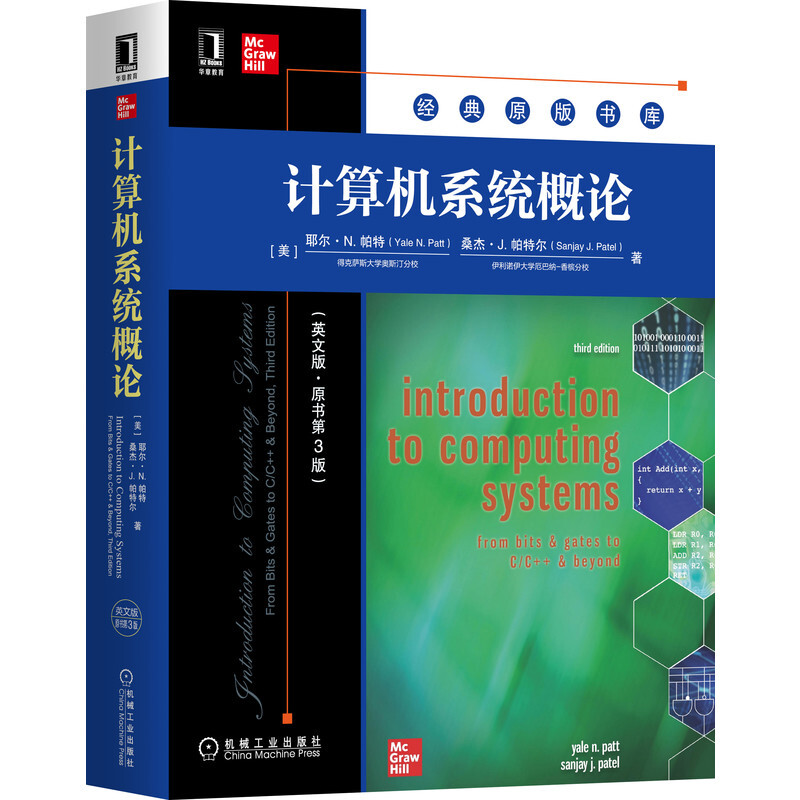
5分
包邮经典原版书库计算机系统概论(英文版原书第3版)/经典原版书库

是机械工业出版社的一手原版英文书籍,大体翻了一遍字迹清晰,页码也没有什么问题。中通快递承接,速度确实慢了一点,送到广州大概四天的时间,但是可以接受。
- ISBN:9787111666318
- 装帧:一般胶版纸
- 册数:暂无
- 重量:暂无
- 开本:16开
- 页数:772
- 出版时间:2020-10-01
- 条形码:9787111666318 ; 978-7-111-66631-8
本书特色
伊利诺伊大学(UIUC)等众多名校采用的计算机科学经典教材,作者是与高德纳齐名的计算机界泰斗Yale Patt
内容简介
本书的目的是让学生在一进入大学校门的时候,就对计算机科学有一个深入理解,为以后的课程打下坚实的基础。本书包括两方面的内容:计算机底层结构;不错语言编程及编程方法学。为加深学生对编程及其方法学的理解。本书采用了自底向上方法,即先给学生一个整体结构,然后自底向上地建立起相关的知识。在每个学习阶段,都基于之前已学的知识介绍新的概念。经验告诉我们,这种学习方法更多地强调理解而不是记忆。通过本书的学习,学生的理解能力将获得很大的提高,因为他们循序渐进地了解了构建计算机的全部过程。
目录
1 Welcome Aboard 1
1.1 What We Will Tryto Do 1
1.2 How We Will Get There 1
1.3 Two Recurring Themes 3
1.3.1 The Notion of Abstraction 3
1.3.2 Hardware vs. Software 5
1.4 A Computer System 7
1.4.1 A (Very) Little History for a(Lot) Better Perspective 8
1.4.2 The Parts of a Computer System 10
1.5 Two Very Important Ideas 11
1.6 Computersas Universal Computational Devices 12
1.7 How Do We Getthe Electrons to Do the Work? 14
1.7.1 The Statement of the Problem 14
1.7.2 The Algorithm 16
1.7.3 The Program 16
1.7.4 The ISA 17
1.7.5 The Microarchitecture 18
1.7.6 The Logic Circuit 19
1.7.7 The Devices 19
Exercises 20
2 Bits, Data Types, and Operations 25
2.1 Bits and Data Types 25
2.1.1 The Bitas the Unit of Information 25
2.1.2 Data Types 26
2.2 Integer Data Types 26
2.2.1 Unsigned Integers 26
2.2.2 Signed Integers 27
2.3 2’s Complement Integers 29
2.4 Conversion Between Binary and Decimal 31
2.4.1 Binary to Decimal Conversion 31
2.4.2 Decimal to Binary Conversion 32
2.4.3 Extending Conversion to Numbers with Fractional Parts 33
2.5 Operations on Bits—Part I: Arithmetic 34
2.5.1 Addition and Subtraction 34
2.5.2 Sign-Extension 36
2.5.3 Overflow 36
2.6 Operations on Bits—Part II:Logical Operations 38
2.6.1 ALogical Variable 38
2.6.2 The AND Function 38
2.6.3 The OR Function 39
2.6.4 The NOT Function 40
2.6.5 The Exclusive-OR Function 40
2.6.6 De Morgan’s Laws 41
2.6.7 The Bit Vector 42
2.7 Other Representations 43
2.7.1 Floating Point Data Type (Greater Range, Less Precision) 43
2.7.2 ASCII Codes 47
2.7.3 Hexadecimal Notation 48
Exercises 49
3 Digital Logic Structures 59
3.1 The Transistor 59
3.2 Logic Gates 61
3.2.1 The NOT Gate (Inverter) 61
3.2.2 OR and NOR Gates 62
3.2.3 Why We Can’t Simply Connect P-Type to Ground 64
3.2.4 AND and NAND Gates 65
3.2.5 Gates with More Than Two Inputs 66
3.3 Combinational Logic Circuits 67
3.3.1 Decoder 67
3.3.2 Mux 68
3.3.3 A One-Bit Adder (a.k.a.a Full Adder) 69
3.3.4 The Programmable Logic Array(PLA)71
3.3.5 Logical Completeness 72
3.4 Basic Storage Elements 73
3.4.1 The R-S Latch 73
3.4.2 The Gated D Latch 74
3.5 The Concept of Memory 75
3.5.1 Address Space 75
3.5.2 Addressability 76
3.5.3 A22-by-3-Bit Memory 76
3.6 Sequential Logic Circuits 78
3.6.1 A Simple Example: The Combination Lock 79
3.6.2 The Concept of State 80
3.6.3 The Finite State Machine and Its State Diagram 82
3.6.4 The Synchronous Finite State Machine 85
3.6.5 The Clock 86
3.6.6 Example: A Danger Sign 87
3.7 Preview of Coming Attractions: The Data Path of the LC-3 93
Exercises 95
4 The von Neumann Model 121
4.1 Basic Components 121
4.1.1 Memory 122
4.1.2 Processing Unit123
4.1.3 Inputand Output 124
4.1.4 Control Unit 125
4.2 The LC-3: An Examplevon Neumann Machine 125
4.3 Instruction Processing 127
4.3.1 The Instruction 127
4.3.2 The Instruction Cycle (NOT the Clock Cycle!) 130
4.3.3 Changing the Sequence of Execution 132
4.3.4 Control of the Instruction Cycle 134
4.3.5 Halting the Computer (the TRAP Instruction) 136
4.4 Our First Program: A Multiplication Algorithm 137
Exercises 139
5 The LC-3 145
5.1 The ISA: Overview 145
5.1.1 Memory Organization 146
5.1.2 Registers 146
5.1.3 The Instruction Set147
5.1.4 Opcodes 149
5.1.5 Data Types 149
5.1.6 Addressing Modes 150
5.1.7 Condition Codes 150
5.2 Operate Instructions 151
5.2.1 ADD, AND, and NOT 151
5.2.2 Immediates 152
5.2.3 The LEA Instruction (Although Not Really an Operate) 154
5.3 Data Movement Instructions 155
5.3.1 PC-Relative Mode 156
5.3.2 Indirect Mode158
5.3.3 Base+offset Mode 159
5.3.4 An Example 160
5.4 Control Instructions 161
5.4.1 Conditional Branches162
5.4.2 Two Methods of Loop Control165
5.4.3 The JMP Instruction 169
5.4.4 The TRAP Instruction 169
5.5 Another Example: Counting Occurrences of a Character 170
5.6 The Data Path Revisited 173
5.6.1 Basic Components of the Data Path 175
5.6.2 The Instruction Cycle Specificto the LC-3 176
Exercises 177
6 Programming 203
6.1 Problem Solving 203
6.1.1 Systematic Decomposition
-

陈澧集(增订本)(全六册)(精装)
¥546.0¥780.0 -

我国静脉产业发展战略
¥37.5¥48.0 -

小吉有点儿等不及
¥4.9¥10.0 -

我是胡小涂.不是小糊涂-小屁孩日记
¥14.0¥18.0 -

模拟电子线路与电源设计(第2分册)/高吉祥/全国大学生电子设计竞赛培训教程
¥39.9¥59.8 -

飞呀飞呀飞上天:飞行的科学-红袋鼠物理千千问
¥16.3¥25.0 -

核心素养.阅读实践:欧洲民间故事
¥20.2¥30.0 -

庆堂印话:孙家潭藏古玺印杂记
¥345.6¥480.0 -

新手学电脑一本通(组装维护上网办公全彩印刷)
¥43.8¥69.0 -

南京历代风华:远古-1840
¥302.4¥480.0
-

造神:人工智能神话的起源和破除 (精装)
¥32.7¥88.0 -

大数据技术导论(第2版)
¥28.9¥41.0 -

人人都能学AI
¥40.4¥68.0 -

人工智能
¥20.3¥55.0 -

过程控制技术(第2版高职高专规划教材)
¥27.6¥38.0 -

数据结构基础(C语言版)(第2版)
¥41.7¥49.0 -

WPS OFFICE完全自学教程(第2版)
¥97.3¥139.0 -

智能视频目标检测与识别技术
¥43.5¥59.0 -

人工智能基础及应用
¥36.0¥48.0 -

深入浅出软件架构
¥117.2¥186.0 -

计算机网络基础(微课版)
¥39.0¥55.0 -

剪映:即梦AI绘画与视频制作从新手到高手
¥66.0¥89.0 -

Web前端开发基础
¥37.5¥57.0 -

软件设计的哲学(第2版)
¥52.0¥69.8 -

人工智能的底层逻辑
¥58.7¥79.0 -

软件工程理论与案例
¥63.4¥99.0 -

剪映+PREMIERE+AIGC 短视频制作速成
¥73.5¥98.0 -

剪映AI
¥52.0¥88.0 -

数据采集与处理
¥36.4¥49.8 -

PLC结构化文本编程(第2版)
¥57.9¥79.0











